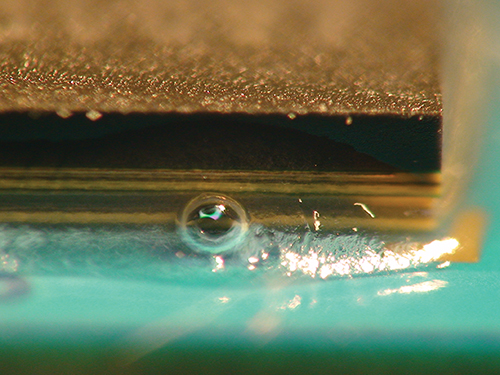Underfill Voiding

Poor reflow profiling can contribute to void-related shorts.
Although you can’t see them, it’s clear that voids or bubbles in underfill materials can be a reliability problem. It’s not obvious how bad the problem could be under parts, as the condition is not easy to identify. Lots of voids means there will be no insulation protection between individual solder terminations. During thermal cycling or in operation, solder can extrude into the voids, leading to shorts. And voids can, of course, lead to corrosion forming between exposed terminations, as moisture can accumulate in these areas.
Voids are typically caused by incorrect profiling during reflow or curing, and depend on the type of underfill used. Outgassing also can be seen on no-flow underfill due to high reflow process temperatures, which permit outgassing from the solder mask to generate voids in the material. The chemical reaction of the material during reflow can be another factor in void formation. Care needs to be taken to follow manufacturers’ recommendations, but simple trials with glass slides may be conducted.
Many products are underfilled today to add mechanical support to a product. This is in contrast to the original purpose of underfill, which was to reduce the impact of thermal expansion mismatch between a component and PCB. In these cases, corner bumping may be a better and cheaper option for the process.
These are typical defects shown in the National Physical Laboratory’s interactive assembly and soldering defects database. The database (http://defectsdatabase.npl.co.uk), available to all this publication’s readers, allows engineers to search and view countless defects and solutions, or to submit defects online. To complement the defect of the month, NPL features the “Defect Video of the Month,” presented online by Bob Willis. This describes over 20 different failure modes, many with video examples of the defect occurring in real time.

Figure 1. It’s very difficult to see underfill voids under components.
is with the National Physical Laboratory Industry and Innovation division (npl.co.uk); chris.hunt@npl.co.uk. His column appears monthly.
Press Releases
- Altus Partners with Sellectronics to Enhance Manufacturing Capabilities with PVA Delta 8 System
- ITW EAE Celebrates Major Milestone in Domestic Manufacturing Expansion
- Micro Technology Services Selects PBT Works CompaCLEAN III for Advanced PCB Cleaning Performance
- Indium Corp. is Electrifying the Future with Advanced Materials Solutions at Productronica







